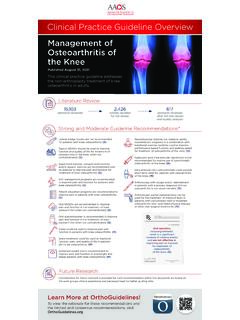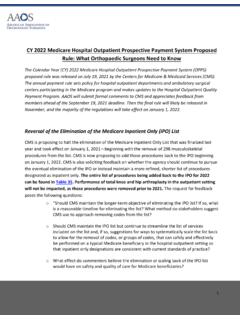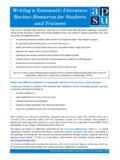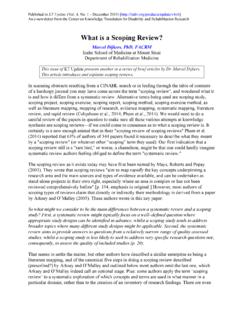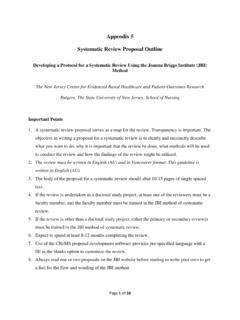Transcription of SYSTEMATIC LITERATURE REVIEW ON THE MANAGEMENT ...
1 1 View background material via the SSI SR eAppendix 1 View data summaries via the SSI SR eAppendix 2 View the SSI Companion Consensus Statements SYSTEMATIC LITERATURE REVIEW ON THE MANAGEMENT OF SURGICAL SITE INFECTIONS Adopted by the American Academy of Orthopaedic Surgeons Board of Directors June 9, 2018 Douglas Lundy, MD; Alexander McLaren, MD; Peter F Sturm, MD; Sudheer Reddy, MD; Gregory S Stacy, MD; Gwo-Chin Lee, MD; Hrayr Basmajian, MD; Thomas Fleeter, MD; Andrew Schoenfeld, MD; Andrew Schoenfeld, MD; Paul Anderson, MD; Sandra Bliss Nelson, ; Kim Chillag, MD; Carter Cassidy, MD; William O. Shaffer; MD; Deborah Cummins, PhD; Jayson Murray, MA; Danielle Schulte, MS; Mukarram Mohiuddin, MPH; Mary DeMars; Kaitlyn Sevarino, MBA; Peter Shores, MPH; Anne Woznica, MLIS, AHIP Endorsed by: Please cite this SYSTEMATIC LITERATURE REVIEW as: American Academy of Orthopaedic Surgeons. SYSTEMATIC LITERATURE REVIEW on the MANAGEMENT of Surgical Site Infections.
2 Published June 9, 2018. 2 View background material via the SSI SR eAppendix 1 View data summaries via the SSI SR eAppendix 2 View the SSI Companion Consensus Statements Disclaimer This SYSTEMATIC LITERATURE REVIEW was developed by an AAOS physician volunteer SYSTEMATIC LITERATURE REVIEW development group based on a SYSTEMATIC REVIEW of the current scientific and clinical information and accepted approaches to treatment and/or diagnosis. This SYSTEMATIC LITERATURE REVIEW is not intended to be a fixed protocol, as some patients may require more or less treatment or different means of diagnosis. Clinical patients may not necessarily be the same as those found in a clinical trial. Patient care and treatment should always be based on a clinician s independent medical judgment, given the individual patient s clinical circumstances. Disclosure Requirement In accordance with AAOS policy, all individuals whose names appear as authors or contributors to SYSTEMATIC LITERATURE reviewfiled a disclosure statement as part of the submission process.
3 All panel members provided full disclosure of potential conflicts of interest prior to voting on the recommendations contained within this SYSTEMATIC LITERATURE reviews. Funding Source This SYSTEMATIC LITERATURE REVIEW was funded exclusively by the American Academy of Orthopaedic Surgeons who received no funding from outside commercial sources to support the development of this document. FDA Clearance Some drugs or medical devices referenced or described in this SYSTEMATIC LITERATURE REVIEW may not have been cleared by the Food and Drug Administration (FDA) or may have been cleared for a specific use only. The FDA has stated that it is the responsibility of the physician to determine the FDA clearance status of each drug or device he or she wishes to use in clinical practice. Copyright All rights reserved. No part of this SYSTEMATIC LITERATURE reviewmay be reproduced, stored in a retrieval system, or transmitted, in any form, or by any means, electronic, mechanical, photocopying, recording, or otherwise, without prior written permission from the AAOS.
4 If you wish to request permission please contact the AAOS Evidence-Based Medicine Unit at Published 2018 by the American Academy of Orthopaedic Surgeons 9400 Higgins Road Rosemont, IL 60018 First Edition Copyright 2018 by the American Academy of Orthopaedic Surgeons 3 View background material via the SSI SR eAppendix 1 View data summaries via the SSI SR eAppendix 2 View the SSI Companion Consensus Statements To View All AAOS Evidence-Based clinical practice guidelines and Appropriate Use Criteria in a User-Friendly Format, Please Visit the OrthoGuidelines Web-Based App at or by downloading to your smartphone or tablet via the Apple and Google Play stores! 4 View background material via the SSI SR eAppendix 1 View data summaries via the SSI SR eAppendix 2 View the SSI Companion Consensus Statements Table of Contents Summary of recommendations .. 5 Medical Imaging .. 5 Cultures.
5 5 C-Reactive Protein .. 5 Erythrocyte Sedimentation Rate .. 5 Clinical Exam for the Diagnosis of Surgical Site Infections .. 5 Strong Evidence of Factors Associated with Increased Risk of SSI .. 6 Moderate Evidence of Increased Associated Risk of SSI .. 6 Limited Evidence of Increased Associated SSI Risk .. 6 Antibiotic duration for MANAGEMENT of surgical site infections .. 7 Rifampin use for MANAGEMENT of surgical site infections .. 7 Development Group Roster .. 8 Voting Members .. 8 Non-Voting Members .. 9 Introduction .. 10 Methods .. 13 Definition of Surgical Site Infection .. 13 Best Evidence Synthesis .. 13 LITERATURE Searches .. 13 Defining the Strength of the Recommendations .. 14 Voting on the 14 Interpreting the Strength of Evidence .. 14 Peer REVIEW .. 15 Public Commentary .. 15 The AAOS SYSTEMATIC LITERATURE REVIEW Approval Process .. 15 Revision Plans .. 15 SYSTEMATIC LITERATURE REVIEW Dissemination Plans.
6 15 Study Attrition Flowchart .. 16 Recommendations .. 17 Medical Imaging .. 17 Cultures .. 20 Prior antibiotic exposure .. 20 C-Reactive Protein .. 22 Erythrocyte Sedimentation Rate .. 23 Clinical Exam for the Diagnosis of Surgical Site Infections .. 24 Strong Evidence of Factors Associated with Increased Risk of SSI .. 25 Moderate Evidence of Increased Associated Risk of SSI .. 29 Limited Evidence of Increased Associated SSI Risk .. 31 Antibiotic duration for MANAGEMENT of surgical site infections .. 32 Rifampin use for MANAGEMENT of surgical site infections .. 33 References .. 34 Guideline Development Group Disclosures .. 52 Voting Members .. 52 Non-Voting Members .. 54 5 View background material via the SSI SR eAppendix 1 View data summaries via the SSI SR eAppendix 2 View the SSI Companion Consensus Statements SUMMARY OF RECOMMENDATIONS MEDICAL IMAGING Limited evidence supports the use of medical imaging in the diagnostic evaluation of patients with a suspected organ/space ( bone, joint, and implant) surgical site infection.
7 Strength of Recommendation: Limited Description: Evidence from two or more Low quality studies with consistent findings or evidence from a single Moderate quality study recommending for or against the intervention or diagnostic test or the evidence is insufficient or conflicting and does not allow a recommendation for or against the intervention. CULTURES Strong evidence supports that synovial fluid and tissue cultures are strong rule-in tests for the diagnosis of infection; negative synovial fluid and tissue cultures do not reliably exclude infection. Strength of Recommendation: Strong Description: Evidence from two or more High strength studies with consistent findings for recommending for or against the intervention. C-REACTIVE PROTEIN Strong evidence supports that C-reactive Protein is a strong rule-in and rule-out marker for patients with suspected surgical site infections. Strength of Recommendation: Strong Description: Evidence from two or more High strength studies with consistent findings for recommending for or against the intervention.
8 ERYTHROCYTE SEDIMENTATION RATE Limited strength evidence does not support the use of ESR, alone, to rule in and rule out surgical site infections due to conflicting data. Strength of Recommendation: Limited Description: Evidence from two or more Low quality studies with consistent findings or evidence from a single Moderate quality study recommending for or against the intervention or diagnostic test or the evidence is insufficient or conflicting and does not allow a recommendation for or against the intervention. CLINICAL EXAM FOR THE DIAGNOSIS OF SURGICAL SITE INFECTIONS Moderate strength evidence supports that clinical exam ( pain, drainage, fever) is a moderate to strong rule-in test ( high probability of presence of infection, if test is positive) for patients with suspected surgical site infections, but a weak rule-out test. Strength of Recommendation: Moderate Description: Evidence from two or more Moderate quality studies with consistent findings, or evidence from a single High quality study for recommending for or against the intervention.
9 6 View background material via the SSI SR eAppendix 1 View data summaries via the SSI SR eAppendix 2 View the SSI Companion Consensus Statements STRONG EVIDENCE OF FACTORS ASSOCIATED WITH INCREASED RISK OF SSI Strong evidence supports that the following factors are associated with an increased risk of infection: Anemia Duration of Hospital Stay Immunosuppressive Medications History of Alcohol Abuse Obesity Depression History of Congestive Heart Failure Dementia HIV/AIDS Strength of Recommendation: Strong Description: Evidence from two or more High strength studies with consistent findings for recommending for or against the intervention. MODERATE EVIDENCE OF INCREASED ASSOCIATED RISK OF SSI Moderate strength evidence supports that patients with chronic kidney disease are at an increased risk of infection after hip and knee arthroplasty. Strength of Recommendation: Moderate Description: Evidence from two or more Moderate quality studies with consistent findings, or evidence from a single High quality study for recommending for or against the intervention.
10 LIMITED EVIDENCE OF INCREASED ASSOCIATED SSI RISK Limited strength evidence supports that patients meeting one or more of the following criteria are at an increased risk of infection after hip and knee arthroplasty: Diabetes (conflicting evidence) Tobacco Use/Smoking (conflicting evidence) Cancer (conflicting evidence) Hypertension (conflicting evidence) Liver Disease (conflicting evidence) Malnutrition (conflicting evidence) Strength of Recommendation: Limited Description: Evidence from two or more Low quality studies with consistent findings or evidence from a single Moderate quality study recommending for or against the intervention or diagnostic test or the evidence is insufficient or conflicting and does not allow a recommendation for or against the intervention. 7 View background material via the SSI SR eAppendix 1 View data summaries via the SSI SR eAppendix 2 View the SSI Companion Consensus Statements ANTIBIOTIC DURATION FOR MANAGEMENT OF SURGICAL SITE INFECTIONS Moderate evidence supports that, in the setting of retained total joint arthroplasty, antibiotic protocols of 8 weeks do not result in significantly different outcomes when compared to protocols of 3 to 6-month duration.
